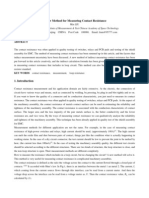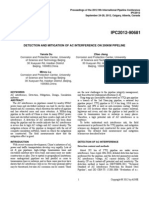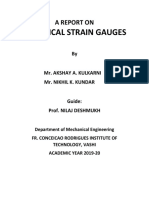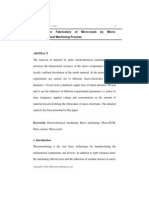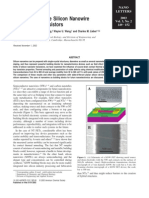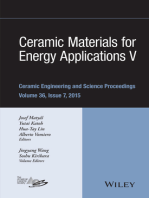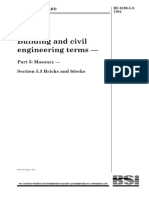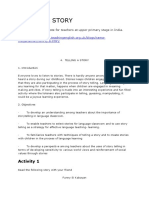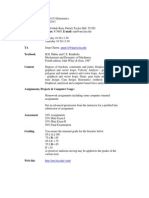Analysis of Resistance Characteristics of Conductive Concrete Using Press-Electrode Method
Analysis of Resistance Characteristics of Conductive Concrete Using Press-Electrode Method
Uploaded by
Shaik AbdullaCopyright:
Available Formats
Analysis of Resistance Characteristics of Conductive Concrete Using Press-Electrode Method
Analysis of Resistance Characteristics of Conductive Concrete Using Press-Electrode Method
Uploaded by
Shaik AbdullaOriginal Title
Copyright
Available Formats
Share this document
Did you find this document useful?
Is this content inappropriate?
Copyright:
Available Formats
Analysis of Resistance Characteristics of Conductive Concrete Using Press-Electrode Method
Analysis of Resistance Characteristics of Conductive Concrete Using Press-Electrode Method
Uploaded by
Shaik AbdullaCopyright:
Available Formats
International Journal of Environmental and Earth Sciences 1:1 2010
Analysis of Resistance Characteristics of Conductive Concrete Using Press-Electrode Method
Chun-Yao Lee and Siang-Ren Wang
AbstractThis paper aims to discuss the influence of resistance characteristic on the high conductive concrete considering the changes of voltage and environment. The high conductive concrete with appropriate proportion is produced to the press-electrode method. The curve of resistivity with the changes of voltage and environment is plotted and the changes of resistivity are explored. Keywordsconductive concrete, resistivity.
II. CONDUCTIVE CONCRETE AND MODELS A. Introduction of conductive concrete The conductive concrete is mixed with a certain amount of conductive material in the cement. Some part of the aggregate in the concrete is replaced by adding metal fibers and metal substances. The conductive concrete known as a compound concrete for special purpose not only maintains its basic mechanical property, but also makes it constitute a conductive network. With the same function as the resistance reducing agent with a lower resistivity, the conductive concrete is particularly employed to the reinforced concrete and road surface. Moreover, the conductive capacity of conductive concrete is different according to the conductive materials and doping concentration. In this paper, materials, proportion and production procedures applied to the conductive concrete is adopted from the reference [5]. The main concrete materials are cement, coarse aggregate, and fine aggregate, and the proportions for each material are 20%-30%, 15%-20%, and 15%-20%, respectively. The conductive material (30%) is further divided to steel fiber (5%), and steel grit (25%). The value of water-cement ratio is between 0.3 and 0.4 approximately. The detailed specification is shown in Table I.
TABLE I MATERIAL AND PROPORTION OF THE CONDUCTIVE CONCRETE Material Proportion Annotation Cement 25% The cement of type I Coarse aggregates 20% Maximum diameter is 30mm Fine aggregates 15% Maximum diameter is 2mm Steel fiber 5% Maximum length is 40mm Steel grit 25% Maximum diameter is 1.42mm Water-cement ratio 0.4 The weight ratio of water and cement The proportion of water is about 15%
I. INTRODUCTION
ITH unique physical property, concrete is widely used around the world. To ensure the road smooth, transportation safety, and the airports operation efficiency, the conductive concrete is commonly to be applied to pave on the roadway. The conductive concrete applied to the road surface with snow is particularly effective, since the road surface can be cleaned rapidly and efficiently. For road maintenance in the area with snow in winter, this project becomes significant [1]-[3]. In addition, for a grounding system, the soil resistivity is the critical concern for a grounding system. The conductive concrete with low resistivity characteristics can be applied to grounding system. In the case of grounding resistance of the transmission tower, if the concrete with conductive property combined with the original grounding grid is applied as the foundation of tower, the grounding resistance of the tower would be greatly reduced. Power from lightning can be dissipated to the earth rapidly, and the transmission reliability can be enhanced. For this reason, many scholars have devoted to the studies related to conductive concrete in recent years [4], [5]. The conductive concrete with conductive and magnetic capacity applied to grounding system would moderately reduce the damage caused by lightning and surge. Therefore, this paper aims to study the resistance characteristics of the conductive concrete using press-electrode method and discusses the influences of voltage and environment corresponding to the resistance characteristics of the high conductive concrete.
This work was supported in part by the National Science Council of Republic of China under Contract NSC 99-2632-E-033-001-MY3. C.-Y. Lee and S.-R. Wang are with the Department of Electrical Engineering, Chung Yuan Christian University, Taoyuan County, Taiwan, 32023. (Phone: +886-3-265-4827; e-mail: chun-yao@ieee.org).
B. Models The press-electrode method is applied to measure the resistivity of conductive concrete in this paper. Then, the resistivity related to time, temperature and voltage are obtained. The measurement method is depicted as follow. The press-electrode method is a simple measurement adopted from the concept in reference [6]. The conductive concrete is regarded as a resistance. The specimen of the
International Journal of Environmental and Earth Sciences 1:1 2010
conductive concrete shares a pair of electrodes for measuring voltage and current, as shown in Fig. 1. This method makes use of adjustable frame to press the electrode and the conductive concrete, that is, this method makes the electrode and the conductive concrete close together. The selected electrode material is made of copper foil and its size should be the same with the cross-sectional area of conductive concrete. Meanwhile, two electrode sides are connected to two wires in
Fig. 2. Measured diagram of the press-electrode method.
III. PRACTICAL MODEL AND MEASUREMENT
A. The practical models The press-electrode method is implemented by means of adjustable pressed device. Because the pressed device is iron made equipment, both the ends of the outer electrode covered with acrylic is to avoid electricity from leaking to the equipment. The moderate pressure is taken to press cooper electrode and the conductive concrete. The conductive concrete
Fig. 1. Structure of the press-electrode method.
which the wire is linked to an ammeter and the DC source is supplied. Consequently, the values of voltage and current are recorded. Formula Ohms law is applied to the two methods and the resistance Rc of the conductive concrete between b and c, and the resistivity are obtained, as shown (1) and (2), respectively.
2 Rr + Rc =
R= l A
C.
V I
(1) (2)
which Rr : electrode resistance () Rc : V : I : : l : A: resistance of the conductive concrete between b and c () the voltage between b and c (V) the current flowing through b and c resistivity of the conductive concrete (m) the length between b and c (m) contact sectional area between the conductive concrete and electrode (m2)
Fig. 3. Flowchart of the resistivity measurement.
International Journal of Environmental and Earth Sciences 1:1 2010
with DC source at electrode side is subsequently connected to ammeter and voltmeter. The measurement instruments contain a set of power supply and two sets of meters, as shown in Fig. 2. The voltage and current considering various factors are recorded.
Date Day 1 Day 2 Day 3 Day 4 Day 5 Day 6 Day 7
TABLE II DATA OF THE RESISTIVITY IN STABLE TEST 2 4 6 Measurement min(s) min(s) min(s) Press-electrode 65.84 65.41 65.66 Press-electrode Press-electrode Press-electrode Press-electrode Press-electrode Press-electrode 76.76 86.28 94.45 102.34 113.49 122.66 76.84 86.31 94.63 102.61 112.95 122.78 77.07 86.36 94.69 102.31 113.75 121.66
8 min(s) 65.45 77.41 86.91 94.92 102.71 112.57 121.13
B. Step of the measurement To measure the effect of time and temperatures using the press-electrode method, a better measurement is chosen when the smaller resistivity without severe change as time varying. Meanwhile, the conductive concrete is placed outside, and the temperature and environmental conditions are recorded. The measurement flowchart is shown in Fig. 3, and the steps are briefly listed below. a. The equipment is prepared for press-electrode method. b. The voltage and current of the conductive concrete are measured using the proposed methods, and the resistivity is calculated according to Ohm's law. c. The stability test is recorded once per 60 seconds. d. The conductive concrete is placed outdoors and it is measured at different temperature and climate conditions. e. The resistivity-time and resistivity-temperature curves are drawn. f. The results of the measurement method is discussed.
IV. THE DATA AND THE MEASURED RESULTS For a better understanding of the influence on the resistivity of the high conductive concrete, temperature and humidity are considered, and the stability of the high conductive concrete is tested using the press-electrode method. The results have shown that by using the press-electrode method, more influencing factors are comprised and the error of the resistivity is relatively high. However, using the method, the generated polarization in process of connecting voltage source cannot be avoided and contact resistance between electrode and the conductive concrete is not reduced. Therefore, the resistivity measurement of the conductive concrete at different voltage cannot obtained through the press-electrode method.
TABLE III DATA OF THE RESISTIVITY IN ENVIRONMENT TEST (PRESS-ELECTRODE METHOD) Drying Temperature () 16 17 18 19 21 23 24 Resistivity (m) 65.83 65.79 65.62 65.56 65.41 65.28 65.15 () 10 11 12 13 14 15 16 Wetting Temperature Resistivity (m) 49.38 48.56 48.31 48.02 47.79 47.53 47.13
A. Time The conductive concrete is not a general dry solid material. When connected to voltage source, the conductive particles inside of the conductive concrete are affected. This phenomenon displays the unstable data obtained from voltmeter and ammeter and results in measurement error every time. To understand the stability and accuracy of the press-electrode method in the process of measurement, the stability of conductive concrete is firstly tested. The data in terms of the press-electrode method is recorded once 60 seconds, and 10 data are recorded in one day. Finally, these data are applied to calculate the resistivity in the unit of (m). The result of the 7-day measurement is shown in Table. II. B. Temperature and moisture of the environment The conductive concrete is placed outdoors. To observe the influence of conductive concrete on resistivity in different environments, including dry and wet conditions, the recorded
Fig. 4. Relation curve of resistivity and temperature in press-electrode method.
data comprising the measurement values in sunny and rainy days are compared. The measurement data using press-electrode method are shown in Table III. Besides, these data is plotted to observe the curves related to resistivity, and outdoor temperature and climate as well, as shown in Fig. 4. V. ANALYSIS AND DISCUSSION OF THE RESULTS The resistivity of the high conductive concrete using press-electrode method is investigated. The resistance characteristics are observed. Since the pore solution of the conductive concrete is gradually decreased in the dry environment, and steel fiber and steel grit would go rust slightly in the alkaline environment of cement, the conductive capacity is gradually decreased. For this, the two factors directly influence the current and make the resistivity increase. The
International Journal of Environmental and Earth Sciences 1:1 2010
result of the stability has shown that resistivity of the conductive concrete significantly increases and the resistivity curve also rises by days, as shown in Table II. Practically, the contact resistance is the main problem that causes to error for the press-electrode method. If there is any gap between the electrode and the concrete, the contact area is decreased, and the current is relatively decreased. By calculation, the contact area is a constant, and hence the resistivity is significantly increased. Moreover, the polarization is generated in the process of power supply for the press-electrode method. The anions are gathered at positive pole and cations are gathered at negative pole. The ions are deposited around the electrode, referred as the polarization response of the concrete. This phenomenon leads to back EMF and makes the measured current value smaller than actual value. As the ions are gradually accumulated around the electrode, the polarization is getting obvious until the polarization is balanced. On the other hand, the conductive concrete with pore solution is capable of either absorbing or evaporating water depending on the moisture change, for this reason, the resistivity of the conductive concrete is varied as the environment change. By observing Fig. 4, when the conductive concrete is placed outdoors, the resistivity of the conductive concrete is influenced by temperature and humidity. The higher the temperature and humidity are, the lower resistivity is, as shown in Table III. Considering the influencing factor of the internal water, after the concrete hydration, many ionic substances, electrolytes, is dissolved in the water and interconnected by capillary. Therefore, as the water increases, the conductive concrete of conductivity is increased and the tightness of the concrete structures is maintained. Comparing the factors between temperature and moisture, the resistivity of conductive concrete is evidently to be affected by water content. In this way, the warm and humid environment results in a lower resistivity for conductive concrete. VI. CONCLUSION The resistivity of the high conductive concrete is computed in this paper using Ohms law, and the press-electrode method is applied to measure and record in different conditions, including time, temperature and voltage. The results have shown that either the higher temperature or the higher humidity results in a smaller the resistivity. In addition, the voltage change also affects internal temperature and the structure of the conductive concrete. The greater the voltage is, the smaller the resistivity is. In sum, the resistivity of the high conductive concrete is not a constant value. The resistivity is not only slightly changed day by day, but also affected by external environment.
Generally, the conductive concrete is widely used for deicing; however, this paper focuses on the application of conductive concrete to grounding system. The important parameter, resistivity, is an indicator in terms of grounding system. The resistance characteristics of the conductive concrete are obtained based on the proposed methods and measured data in this paper. The characteristics of the high conductive concrete corresponding to the grounding standard completely can be applied to grounding effectively. ACKNOWLEDGMENT The authors would like to thank Professor Chih-Ju Chou and his research center in Dept. Electrical Engineering of National Taipei University of Technology in providing the suggestions of the research. The authors also would like to thank Professor Ming-Yi Liu, Chung-Min Ho and their Labs. in Chung Yuan Christian University in providing the measurement equipments. REFERENCES
[1] C. Y. Tuan, S. A. Yehia, Implementation of Conductive Concrete Overlay for Bridge Deck Deicing at Roca, Nebraska, Transportation Research E-Circular, No. E-C063, Jun. 2004, pp. 363-378. [2] [3] C. Y. Tuan, Conductive Concrete for Bridge Deck Deicing and Anti-Icing, University of Nebraska, Lincoln, Jul. 2004, pp.168. C. Y. Tuan, Roca Spur Bridge: The Implementation of an Innovative Deicing Technology, American Society of Civil Engineers, Vol. 22, Issue 1, Mar. 2008, pp. 1-15. [4] Yehia S, Christopher Y T, Ferdon D, eta1. Conductive concrete overlay for bridge deck deicing: mixture proportioning, optimization, and properties [J], ACI Materials Journal, 2000, 97(2): pp. 172-181. [5] Hou Zuo-Fu, Li Zhuo-Qiu, Hu Sheng-Liang, Resistivity Research on Carbon Fibre Electrically Conductive Concrete for Deicing and Snow Melting, Journal of Yangtze University (Nat Sci Edit) Vo1. 2, No. 7, pp. 264-266, Ju1. 2005. [6] Shen Gang, Dong Faqin, He Dengliang, Study on Graphite and Steel Fiber Composite Electrically Conductive concrete, Bulletin of the Chinese Ceramic Society, No. 6, 2004. Chun-Yao Lee (SM04, M08) received his Ph.D. in electrical engineering from National Taiwan University of Science and Technology in 2007. In 2008, he joined Chung Yuan Christian University as a faculty member. Dr. Lee was a visiting Ph.D. at University of Washington, Seattle, during 2004-05 and worked for engineering division, Taipei Government as distribution system designer during 2001-2008. His research interests include power distribution and filter design. Dr. Lee is a member of the IEEE Taipei Section Siang-Ren Wang was born in Taiwan in 1986. He received his B.S. degree in electrical engineering from Chung Yuan Christian University in 2008. Mr. Wang will be an electrical engineer in a year in Taiwan.
10
You might also like
- Shamballa Multidimensional Healing Level 3: Distance Course NotesDocument32 pagesShamballa Multidimensional Healing Level 3: Distance Course NotesÇrirajasaSangamurwabhumiSiwikencanaDharmawangçateguhNo ratings yet
- Electrical Resistivity Measurement of ConcreteDocument4 pagesElectrical Resistivity Measurement of ConcreteJojo Dela CruzNo ratings yet
- Evaluation of Concrete Permeability by Critical Voltage: Xinying Lu, Meixia Chen, Fang YuanDocument3 pagesEvaluation of Concrete Permeability by Critical Voltage: Xinying Lu, Meixia Chen, Fang YuanAngel_JK99No ratings yet
- Concrete Electrical ResistivityDocument7 pagesConcrete Electrical Resistivitysoulmateforeverforu100% (1)
- Effect of Voltage On Mechanical Properties of CarbDocument7 pagesEffect of Voltage On Mechanical Properties of CarbAditya SutarNo ratings yet
- ID FanDocument7 pagesID FanDony RamdhaniNo ratings yet
- Electrical Resistivity Measurement of Concrete - Wikipedia - PDF (NON CONTACTDocument4 pagesElectrical Resistivity Measurement of Concrete - Wikipedia - PDF (NON CONTACTjucar fernandezNo ratings yet
- PrintedDocument7 pagesPrintedFari PratomosiwiNo ratings yet
- KEM.834.10 JHGHJHJBDocument6 pagesKEM.834.10 JHGHJHJBjamel-shamsNo ratings yet
- Hydration Monitoring of Cement-Based MaterialsDocument10 pagesHydration Monitoring of Cement-Based MaterialsJerry SethiNo ratings yet
- A New Method For Measuring Contact ResistanceDocument4 pagesA New Method For Measuring Contact ResistanceSenthil CuddaloraNo ratings yet
- Electrical Discharge Machining of Oxide Nanocomposite: Nanomodification of Surface and Subsurface LayersDocument28 pagesElectrical Discharge Machining of Oxide Nanocomposite: Nanomodification of Surface and Subsurface LayersLucian DragosNo ratings yet
- Corrosion - Assessment - Methods - in - Reinforced - Cement - (Các Phương Pháp Đánh Giá Ăn Mòn Trong Bê Tông Xi Măng Cốt Thép)Document15 pagesCorrosion - Assessment - Methods - in - Reinforced - Cement - (Các Phương Pháp Đánh Giá Ăn Mòn Trong Bê Tông Xi Măng Cốt Thép)TÚ TRẦN MINHNo ratings yet
- Mechatronics Electrical PowerDocument8 pagesMechatronics Electrical PowerDedijumaediNo ratings yet
- Critical Chloride Concentration of Rebar Corrosion in Fly Ash ConcreteDocument18 pagesCritical Chloride Concentration of Rebar Corrosion in Fly Ash ConcreteJHON WILMAR CARDENAS PULIDONo ratings yet
- Cyme GridDocument6 pagesCyme Gridprabhakaran_hdec100% (1)
- Fluid Dynamic Simulation and Experimental Study of Honeycomb Seal Structures in Electrochemical Discharge Machining PressureDocument17 pagesFluid Dynamic Simulation and Experimental Study of Honeycomb Seal Structures in Electrochemical Discharge Machining PressuremechjournalNo ratings yet
- Aguado Measurement 1Document6 pagesAguado Measurement 1HADHI HASSAN KHANNo ratings yet
- Concrete Electrical ResistivityDocument7 pagesConcrete Electrical ResistivityFernando MoitaNo ratings yet
- CCC 9487Document6 pagesCCC 9487maxence.bigerelleNo ratings yet
- A Comparative Study of Additively Manufactured Thin Wall and Block Structure With Al-6.3%Cu Alloy Using Cold Metal Transfer ProcessDocument11 pagesA Comparative Study of Additively Manufactured Thin Wall and Block Structure With Al-6.3%Cu Alloy Using Cold Metal Transfer ProcessJinoop A NNo ratings yet
- The Permeability at Ions Chlorinates As Indicator of Durability of ConcretesDocument4 pagesThe Permeability at Ions Chlorinates As Indicator of Durability of ConcretesInternational Journal of Application or Innovation in Engineering & ManagementNo ratings yet
- Numerical Study of Coated Electrical ContactsDocument6 pagesNumerical Study of Coated Electrical ContactsHilary OlsonNo ratings yet
- 2.1.4 Half-Cell PotentiometerDocument3 pages2.1.4 Half-Cell PotentiometerTejaSriNo ratings yet
- Elastomeric Electronics: A Microfluidic Approach: Shi ChengDocument20 pagesElastomeric Electronics: A Microfluidic Approach: Shi ChengVignesh RamakrishnanNo ratings yet
- Impedance Spectroscopy in Reinforced Concrete: Procedure For Monitoring Steel CorrosionDocument6 pagesImpedance Spectroscopy in Reinforced Concrete: Procedure For Monitoring Steel CorrosionhadiNo ratings yet
- Detection and Mitigation of Ac Interference On 200Km PipelineDocument5 pagesDetection and Mitigation of Ac Interference On 200Km PipelineMarcelo Varejão CasarinNo ratings yet
- Electrical Strain Gauges: A Report OnDocument31 pagesElectrical Strain Gauges: A Report OnAnonymous GRY6OCJNo ratings yet
- Analysis On Fabrication of Micro-Tools by Micro-Electrochemical Machining ProcessDocument33 pagesAnalysis On Fabrication of Micro-Tools by Micro-Electrochemical Machining ProcessXu WeixingNo ratings yet
- An Experimental Study of Air Breakdown Voltage - J. Electrical SystemsDocument9 pagesAn Experimental Study of Air Breakdown Voltage - J. Electrical Systemsdineshsoni29685100% (1)
- Effect of Surface Shallow Traps On FlashoverDocument7 pagesEffect of Surface Shallow Traps On FlashoverVU Thi Thu NgaNo ratings yet
- Design Calculation and Performance Testing of Heating Coil in Induction Surface Hardening Machine PDFDocument5 pagesDesign Calculation and Performance Testing of Heating Coil in Induction Surface Hardening Machine PDFMohammedNo ratings yet
- Study of Impressed Current Cathodic Protection (ICCP) On The Steel Pipeline Under DC Stray Current InterferenceDocument17 pagesStudy of Impressed Current Cathodic Protection (ICCP) On The Steel Pipeline Under DC Stray Current InterferenceMahir DžafićNo ratings yet
- Apparatus Required: 1.ammeter 2.voltmeter 3.copper Wires A.thickness-B. LengthDocument12 pagesApparatus Required: 1.ammeter 2.voltmeter 3.copper Wires A.thickness-B. LengthJason PadillaNo ratings yet
- NPSC RVI InsulatorsDocument4 pagesNPSC RVI InsulatorsJordan RileyNo ratings yet
- Corrosion Resistance Performance of Fly Ash Blended Cement ConcretesDocument7 pagesCorrosion Resistance Performance of Fly Ash Blended Cement ConcretesesatjournalsNo ratings yet
- Character Is at Ion of Polyimides Under High-Temperature SlidingDocument8 pagesCharacter Is at Ion of Polyimides Under High-Temperature SlidingAlberto GamberiniNo ratings yet
- Optimization and Development of Contact Wire For High Speed LinesDocument9 pagesOptimization and Development of Contact Wire For High Speed Linesdineshsoni29685No ratings yet
- Applsci 10 09152 v2Document42 pagesApplsci 10 09152 v2Gil Angelo Del ValleNo ratings yet
- Cement Based ElectronicsDocument11 pagesCement Based ElectronicsDEBORAHVSNo ratings yet
- Temperature Effects On Fatigue of Polymer CompositesDocument3 pagesTemperature Effects On Fatigue of Polymer CompositesTeoman UrceNo ratings yet
- Comparison of Finite-Element and IEC Methods For Cable Thermal Analysis Under Various Operating Environments (Kady2014)Document6 pagesComparison of Finite-Element and IEC Methods For Cable Thermal Analysis Under Various Operating Environments (Kady2014)daegerteNo ratings yet
- Charpy Impact Test: An Overview of Mechanical and Physical Testing of Composite MaterialsDocument11 pagesCharpy Impact Test: An Overview of Mechanical and Physical Testing of Composite MaterialswaniNo ratings yet
- Electro Chemical Discharge MachiningDocument20 pagesElectro Chemical Discharge MachininglokeshNo ratings yet
- Refer en CIA 10Document8 pagesRefer en CIA 10Ianina VioliNo ratings yet
- On The Tensile Resistance of UHPC at Impact: T E P JDocument11 pagesOn The Tensile Resistance of UHPC at Impact: T E P Jsina zolfagharyNo ratings yet
- The Influence of Aging Time and Moisture Content oDocument7 pagesThe Influence of Aging Time and Moisture Content oTri Suprapti HandayaniNo ratings yet
- Development of Electrochemical Micro Machining For Air-Lubricated Hydrodynamic BearingsDocument6 pagesDevelopment of Electrochemical Micro Machining For Air-Lubricated Hydrodynamic BearingsMark LambertNo ratings yet
- Durability Assessment of Concrete by Using Electrical Resistivity & Rapid Chloride Permeability TechniqueDocument5 pagesDurability Assessment of Concrete by Using Electrical Resistivity & Rapid Chloride Permeability TechniqueMuhammad ZainiNo ratings yet
- A New Method For Determining The Connection ResistDocument19 pagesA New Method For Determining The Connection ResistЖандос ТлешовNo ratings yet
- 1 - Artigo 37 PDFDocument10 pages1 - Artigo 37 PDFTatiane GabiNo ratings yet
- Comparison of Chloride Diffusion Coefficient Evaluation Based On Electrochemical MethodsDocument6 pagesComparison of Chloride Diffusion Coefficient Evaluation Based On Electrochemical MethodsYash DhabaliaNo ratings yet
- LIDO - 2019 - Soon Shi - Comparison of 1D and 3D Water Hammer Analysis For Fast Transients in Nuclear Power PlantDocument8 pagesLIDO - 2019 - Soon Shi - Comparison of 1D and 3D Water Hammer Analysis For Fast Transients in Nuclear Power PlantJean Carlos DiasNo ratings yet
- Structure and Electrical PropertiesDocument8 pagesStructure and Electrical PropertiesAlexander LyashkovNo ratings yet
- HR Asia, Apr 2011Document4 pagesHR Asia, Apr 2011emediageNo ratings yet
- Kendriya Vidyalaya M.E.G and Centre Bangalore: Physics Project ReportDocument17 pagesKendriya Vidyalaya M.E.G and Centre Bangalore: Physics Project ReportJason PadillaNo ratings yet
- Crimping TestDocument6 pagesCrimping TestAmit VijayvargiyaNo ratings yet
- An Essential Guide to Electronic Material Surfaces and InterfacesFrom EverandAn Essential Guide to Electronic Material Surfaces and InterfacesNo ratings yet
- Ceramic Materials for Energy Applications V: A Collection of Papers Presented at the 39th International Conference on Advanced Ceramics and CompositesFrom EverandCeramic Materials for Energy Applications V: A Collection of Papers Presented at the 39th International Conference on Advanced Ceramics and CompositesJosef MatyášNo ratings yet
- PForeword PDFDocument3 pagesPForeword PDFShaik AbdullaNo ratings yet
- 02.civil Specs P2Document217 pages02.civil Specs P2Shaik AbdullaNo ratings yet
- 3.1 Delivery 3.3 Storage and Maintenance of Application ToolsDocument1 page3.1 Delivery 3.3 Storage and Maintenance of Application ToolsShaik AbdullaNo ratings yet
- East Elevation South Elevation: NotesDocument1 pageEast Elevation South Elevation: NotesShaik AbdullaNo ratings yet
- PAcknowledgeDocument2 pagesPAcknowledgeShaik AbdullaNo ratings yet
- A747 308 81 41 37195 - Rev 1Document1 pageA747 308 81 41 37195 - Rev 1Shaik AbdullaNo ratings yet
- Dg-1 (Remote Radiator) Above Control Room Slab: 05-MAR-2018 Atluri Mohan Krishna (B845)Document32 pagesDg-1 (Remote Radiator) Above Control Room Slab: 05-MAR-2018 Atluri Mohan Krishna (B845)Shaik AbdullaNo ratings yet
- SLOPE 1:6: Dg-1 (Remote Radiator) Above Control Room SlabDocument7 pagesSLOPE 1:6: Dg-1 (Remote Radiator) Above Control Room SlabShaik AbdullaNo ratings yet
- Concrete: Jump To Navigationjump To Search Concrete (Disambiguation) Cement Grout Mortar (Masonry) PlasterDocument5 pagesConcrete: Jump To Navigationjump To Search Concrete (Disambiguation) Cement Grout Mortar (Masonry) PlasterShaik AbdullaNo ratings yet
- BS 6100 5 3 PDFDocument12 pagesBS 6100 5 3 PDFShaik AbdullaNo ratings yet
- Slab Supporing SystemDocument1 pageSlab Supporing SystemShaik AbdullaNo ratings yet
- Slab ShoringDocument1 pageSlab ShoringShaik AbdullaNo ratings yet
- Deir El-BersheDocument11 pagesDeir El-BersheMina Sami Fred YacobNo ratings yet
- Polmlek Katalog en Kwiecien22 LightDocument41 pagesPolmlek Katalog en Kwiecien22 LightAziz AIT SALAHNo ratings yet
- DLL Science 10Document40 pagesDLL Science 10Raiza Lainah MianoNo ratings yet
- Chapter 9 Uniform Circular MotionDocument10 pagesChapter 9 Uniform Circular MotionZhu JiankunNo ratings yet
- Automatic Change-Over SwitchDocument7 pagesAutomatic Change-Over SwitchFaizan Nazir100% (1)
- Telling A Story: This Is A Module I Wrote For Teachers at Upper Primary Stage in India. SourceDocument13 pagesTelling A Story: This Is A Module I Wrote For Teachers at Upper Primary Stage in India. SourceYogita Bhamare100% (1)
- Historical Antecedents RetardoDocument125 pagesHistorical Antecedents RetardoRerey ValesNo ratings yet
- Grade Xii - A Assignment (Maths)Document3 pagesGrade Xii - A Assignment (Maths)Jegadheesvaran MNo ratings yet
- STE LAS BioTech MELC 7 Q1 Week-6Document7 pagesSTE LAS BioTech MELC 7 Q1 Week-6Sheila mae tabuenaNo ratings yet
- Dickens and London PDFDocument17 pagesDickens and London PDFtrishaNo ratings yet
- S. MS 1500 - 2019 Halal Food-General Re (3rd Rev)Document22 pagesS. MS 1500 - 2019 Halal Food-General Re (3rd Rev)Nurul hatikahNo ratings yet
- EFFC & DFI - Tremie Concrete For Deep Foundations 2018Document83 pagesEFFC & DFI - Tremie Concrete For Deep Foundations 2018Nelson ChinNo ratings yet
- Chapter 3 Unit 1 Brock Biology of Microorganisms, Ebook, Global EditionDocument33 pagesChapter 3 Unit 1 Brock Biology of Microorganisms, Ebook, Global Edition22063 - Trần Chí HiệpNo ratings yet
- Lecturenotes 1Document4 pagesLecturenotes 1Anubhav VardhanNo ratings yet
- Torque, ITT, NP, and NG Explained On Turboprop Engines - Airplane AcademyDocument15 pagesTorque, ITT, NP, and NG Explained On Turboprop Engines - Airplane Academyrüveyda ışıkNo ratings yet
- (Underwater) Panty and Stocking With Garterbelt - 01-13 + OVA (BD 720p) (Dual Audio) (Batch) - TorrentDocument1 page(Underwater) Panty and Stocking With Garterbelt - 01-13 + OVA (BD 720p) (Dual Audio) (Batch) - TorrentzanetowerfinderNo ratings yet
- Arizona Engineer Fall 2006Document20 pagesArizona Engineer Fall 2006UA College of Engineering100% (1)
- Brochure SunflagDocument12 pagesBrochure SunflagkunalNo ratings yet
- Grade 10 ModuleDocument62 pagesGrade 10 ModuletabilinNo ratings yet
- 2009 2011 DS Manual - Club Car (001-061)Document61 pages2009 2011 DS Manual - Club Car (001-061)misaNo ratings yet
- Opportunities and Challenges For Mesh Networks Using Directional AntennasDocument24 pagesOpportunities and Challenges For Mesh Networks Using Directional AntennasbaruaeeeNo ratings yet
- OM W04 + Productivity and Competitiveness 2022Document59 pagesOM W04 + Productivity and Competitiveness 2022Celeste Huaman MejiaNo ratings yet
- EXW-GENL-0000-PE-KBR-IP-00019 Interim Advice Note 019Document84 pagesEXW-GENL-0000-PE-KBR-IP-00019 Interim Advice Note 019Henry TuganoNo ratings yet
- ME 4133 SyllabusDocument1 pageME 4133 Syllabusjklmn567No ratings yet
- 05 02 Direct Method of InterpolationDocument9 pages05 02 Direct Method of InterpolationJohn Bofarull Guix100% (1)
- Penawaran Hotel Mega Matra ENGLISHDocument1 pagePenawaran Hotel Mega Matra ENGLISHmega matNo ratings yet
- Mahakam Upstream Travel PatternDocument6 pagesMahakam Upstream Travel PatternsaypunyaNo ratings yet
- Property: in General, Things Are EitherDocument14 pagesProperty: in General, Things Are EitherCy DacerNo ratings yet
- 4 Paper 4, J Coord ChemDocument17 pages4 Paper 4, J Coord ChemMuhammad IqbalNo ratings yet










